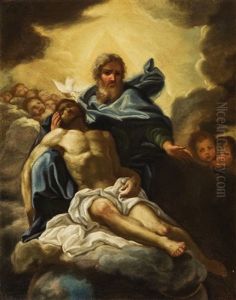Vito D'Anna Paintings
Vito D'Anna was an Italian painter, born in 1718 in Palermo, Sicily, into the flourishing Baroque period that dominated Italian art and architecture. His life and career were primarily anchored in his native city, where he became one of the most prominent Sicilian painters of the 18th century. D'Anna's artistry was deeply influenced by the Baroque style, characterized by dramatic use of color, light, and shadow, and a dynamic sense of movement, all of which were masterfully integrated into his compositions.
Educated initially by his father, Antonio D'Anna, who was also a painter, Vito later expanded his artistic vision through studies with notable painters of his time. His work was profoundly influenced by Flemish and French painting, alongside the rich artistic traditions of Italy. D'Anna is especially celebrated for his frescoes and religious paintings. His ability to blend the grandeur of Baroque art with the emerging Rococo style, noted for its lighter elements and ornamental details, set his work apart.
Among his most significant works are the frescoes in the Palazzo Isnello and the Palazzo Ajutamicristo in Palermo, which showcase his skill in creating complex narrative scenes filled with emotional depth and architectural detail. His religious paintings, found in many Sicilian churches, are revered for their spiritual intensity and the virtuosity of their execution. D'Anna's depiction of light, in particular, gives his religious scenes a transcendent quality, bridging the earthly with the divine.
D'Anna's influence extended beyond his immediate contemporaries, contributing to the development of Sicilian Baroque and setting a precedent for later artists in Sicily and beyond. Despite his death in 1769, his legacy endured, cementing his status as a pivotal figure in the evolution of 18th-century Italian art. His works continue to be studied and admired for their beauty, technical skill, and historical significance in the rich tapestry of Italian art history.

